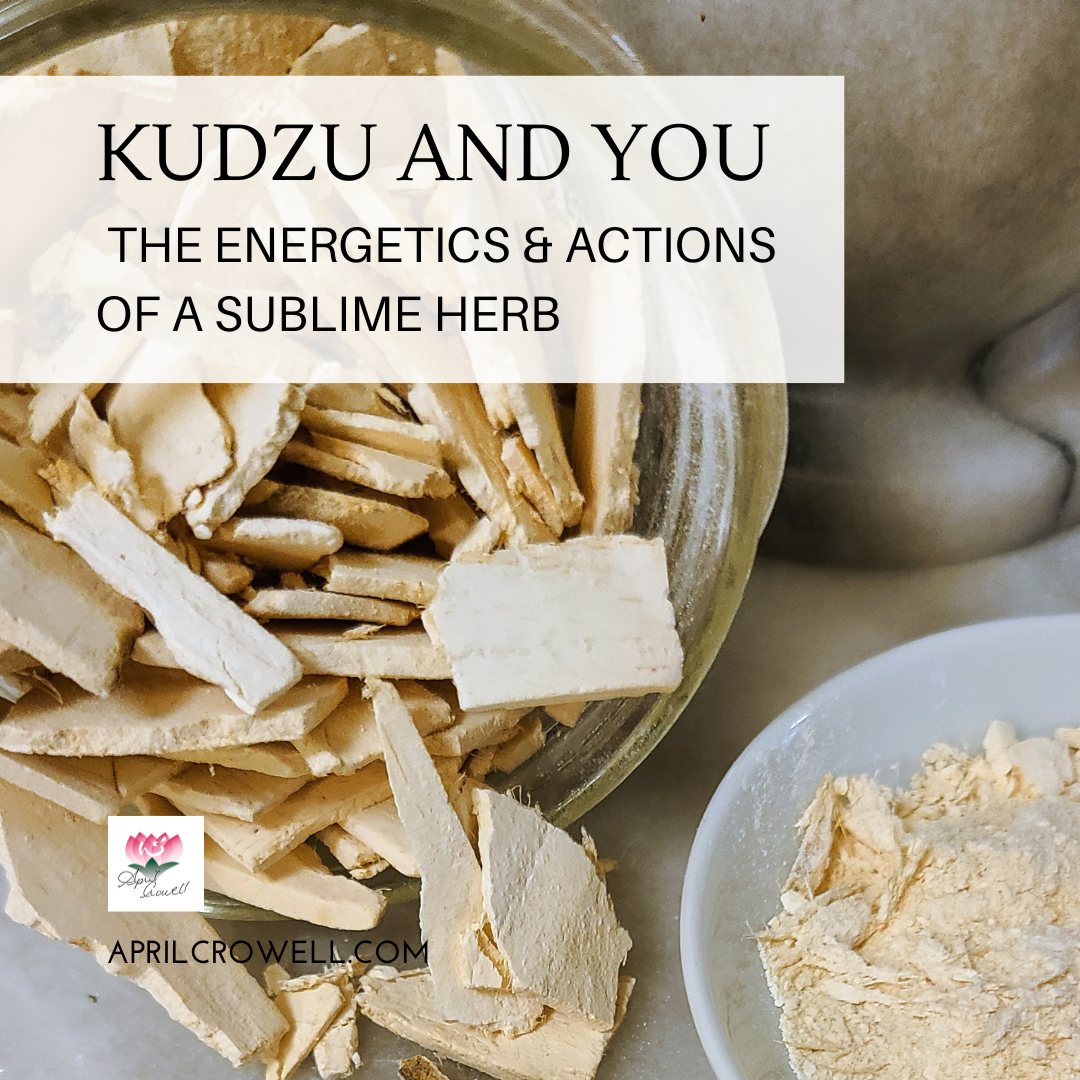Kudzu And You - The Energetics And Actions of a Sublime Herb
Kudzu, kuzu, pueraria or ge gen - they are all names for one of my favorite and most recommended herbs.
A member of leguminosae family ge gen has been used for centuries. Kudzu is truly a sublime herb. It's used regularly in cooking for foods such as age dashi and teas, or as a simple kitchen remedy for colds, flu, stiff necks and stomachaches. It's gentle enough for children, elderly or the sick and recovering. Ge gen has been used for centuries in Chinese herbal formulas for releasing exterior pathogens, especially heat and wind, and in formulas that aid digestion and relax the channels and muscles.
Puerarin, the biological active ingredient in pueraria, is being studied widely for treatment of patterns including diabetes, alcoholism, hypertension, Parkinson’s and Alzheimer’s. That’s the short list. Research into its effects on the breast tissue indicates it can keep estrogen from triggering breast cysts, making it a potentially valuable player in the prevention and treatment of breast cancers. It has turned out to be a star performer in the treatment of Covid 19 and Long-Covid.
Bonus - it's an invasive species in the south. That means you can get it relatively locally and it's not an endangered plant. This amazing vine is taking over the south, leaving areas looking like something out of a Miyazaki film. Frankly, they need help getting it under control. The best times for harvest are in the early Spring around Easter and just after the first frost in the fall.
Kudzu’s energetics —Sweet, acrid and cooling. It enters the Stomach and Spleen.
Releases to the exterior, counters wind, and releases the muscles — Ge gen appears in numerous classic Chinese herbal formulas that are used to relax the sinews and relieve exterior invasion. It specifically targets the neck and shoulders. Reach for the kudzu if you have a stiff neck, headache, tight jaw or sinus and congestion caused by the wind.
Nourishes fluids, clears Stomach heat, and alleviates thirst — Cools and clears heat in the Stomach especially heat from an exterior invasion - darn fevers. This can manifest as a very red tongue, gnawing hunger, thirst, dry stools, nervousness, red gums, foul breath, and the desire to remove one’s clothing. Yeah - it’s a thing.
Kudzu is often combined with other herbs to treat numerous patterns, especially wasting and thirsting syndromes including diabetes, hot flashes and tuberculosis.
Roasting the root reduces some of its cooling effects and is better suited to diarrhea caused by Spleen deficiency - cold, loose stools with no foul odor.
Vents measles and rashes — Cools and clears wind heat and allows rashes to vent. Think measles, mumps, chicken pox, shingles, eczema, any allergic skins rashes whether they are on the face, lips or ankles. Look for hot skin conditions, maybe oozing and gooey too.
Alleviates diarrhea — Kudzu is mostly used for hot pattern diarrhea - explosive, foul smelling bowels, with urgency. These are often caused by exterior invasion of heat. Eating overly spicy, greasy, hot foods or getting food poisoning technically falls under ‘exterior invasion’ in Chinese medicine terms. Back off the ghost peppers.
Treats hypertension and dizziness — Kudzu helps calm down all that ascending Yang that can lead to headaches, tinnitus, dizziness, and angina.
Caution — None. There are no noted contraindications - that is something that cannot be said of many herbs and foods. There’s a bit of magic happening here.
How to use kudzu
Kudzu can be used as a food, a simple kitchen remedy, or in strong herbal combinations to fight something acute. The dosing form used is obviously going to vary depending on what you are using it for.
Cook with it — Kudzu can be used as a thickening agent similar to agar agar or cornstarch. Check out my Age Dashi recipe.
Make a cup of tea — A favorite in the Japanese culture and especially in macrobiotic cooking. Use 1 tsp of finely ground kudzu for a cup of tea, and add in additional ingredients as desired. Kudzu has no particular taste other than sweet and chalky. Adding in fresh or dried ginger will warm you right up, and you may want to avoid this combo if you have hypertension or hot flashes. If you are battling heat patterns use hibiscus or mint to soothe and cool. mmmm… Here’s a simple recipe.
Make kudzu goo — Frozen, stiff or sore neck, slept wrong, pulled too many weeds at once, treated too many muscular clients? Let’s up the kudzu game. In a small pan dissolve 2 Tsp of ground kudzu, dissolve in 1 cup of warm water to dissolve over medium heat. Stir until it thickens, to a thin pudding texture. Remove from heat, add in a pinch of cinnamon and kiss of maple syrup. Eat by the teaspoon over an hour until your neck and shoulder free up. Be sure to wrap up in a scarf and get in out of the wind and cold.
Use is as a single herb — My favorite way to carry it for travel and to have on hand for ease of use. There are numerous good companies carrying it and it is readily available at many health food stores.
Use it in a formula — It is in many formulas. Unless you have herbal training, seek guidance here to find the right formula to treat your particular pathology.
Need help deciding? Book online consultations or in person Amma sessions here.
Cheers!





